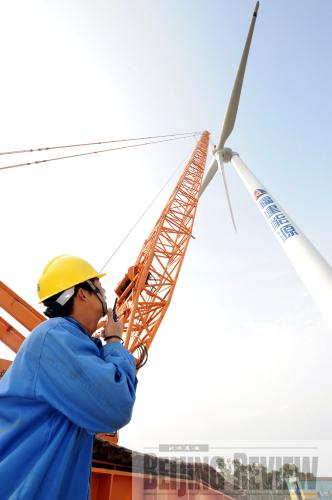|
 |
|
WIND POWER: An engineer installs equipment at the Shijing Wind Power Station in the city of Putian, south China's Fujian Province, on April 16. The province has contributed to the rapid development of wind power in recent years by setting up wind power stations for commercial use in Putian and Zhangzhou (JIANG KEHONG) |
China is working on a new plan to revitalize the alternative energy industry, which is scheduled to be published at the end of this month, Shi Jingli, a research fellow at the Energy Research Institute under the National Development and Reform Commission (NDRC), told China Energy News recently.
The most striking difference in the new plan is the more ambitious production goals compared with the mid- to long-term renewable energy plan and the 11th Five-Year (2006-2010) Plan on Development of Renewable Energy issued in 2007, Wang Mengjie, Vice President of the Chinese Renewable Energy Society (CRES), recently told Xinhua News Agency.
Under the 2007 plan, China planned to achieve wind and biomass power of 30 gigawatts each and solar power of 1.8 gigawatts by 2020. The electricity generated by renewable energy is to meet more than 15 percent of the country's total need by 2020, and 30 percent or higher by 2040.
"The new plan increases the wind capacity goal to between 100 gigawatts to 150 gigawatts, because we might reach the target of 30 gigawatts as early as 2011," said Shi Pengfei, Vice Director of the Chinese Wind Energy Association.
According to a report in China Business News, officials are working on a new stimulus package that contains at least 2 trillion yuan ($294 billion) for investment in renewable energy, with wind and solar power benefiting the most.
The stimulus package will supplement the revitalization plan for 10 industries released at the end of last year and the beginning of this year.
"Investment in wind energy will reach 1 trillion yuan ($147 billion)," an official close to the plan told China Business News. "If calculated at current costs, that's 8,000 yuan to 10,000 yuan for 1 kwh."
The government has already confirmed several 10-gigavatt wind power bases in Hebei, Gansu, Jiangsu and Jilin provinces, as well as Inner Mongolia Autonomous Region. The combined planned wind capacity in east and west Inner Mongolia alone is a record 50 gigawatts, while Hebei and Gansu have set their targets at 10 gigawatts each.
The solar photovoltaic industry should also benefit from the new stimulus package. CRES Vice President Zhou Yuwen estimates that photovoltaic capacity will reach 10 gigawatts by 2020 and receive more than 300 billion yuan ($44 billion) in investment.
The new plan has a huge impact on the development of nuclear power, the official said. Investment in this sector will be 750 billion yuan ($110 billion), as the current investment for 1 kwh is 14,000 yuan to 15,000 yuan, said Li Yahui, an analyst at TX Investment Consulting Co. Ltd.
According to the Energy Bureau under the NDRC, by 2020, nuclear power capacity in China will exceed 70 gigawatts, or more than 5 percent of the country's total electricity use.
In 2004, the country started producing ethanol-based fuel for automobiles in 27 cities in nine provinces including Heilongjiang, Henan and Shandong; output in 2006 stood at 1.65 million tons. The country slowed its production pace since 2007, due to a government policy limiting the use of corn to produce ethanol.
According to the CRES, China has also used non-grain staples, including sweet sorghum, cassavas and lignocelluloses, as raw materials to research, develop and produce liquid bio-fuels. It also uses oil plants such as seeds from tung trees to make bio-diesel products. Large bases producing these raw materials have been established nationwide, along with enterprises processing bio-liquid fuels.
The original plan says that ethanol production will reach 2 million tons annually by 2010, while bio-diesel output is projected to be 200,000 tons. The two alternative energies are expected to replace 2 million tons of oil. "These figures are relatively adjusted in the new plan," the official said. | 